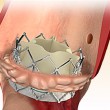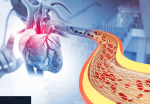Reference: Afilalo J, RAsti M, Ohayon SM, et al. Off-pump vs on-pump coronary artery bypass surgery: an updated meta-analysis and meta-reggresion of randomized trials. Eur Heart J 2011. Epub ahead of print. Patients who undergo off-pump coronary artery bypass grafting (CABG) surgery experience nearly one-third fewer postoperative strokes than those who receive standard surgery using cardiopulmonary...
Intravascular Lithotripsy: Outcomes and Trends in the Treatment of Calcified Coronary Lesions
Lately, the complexity of percutaneous coronary artery interventions (PCI) has seen an increase, mainly driven by the increasing prevalence of coronary lesion calcification, which represents a significant challenge for interventionists. Untreated calcification might result in insufficient stent expansion, a high risk factor of thrombosis and instent restenosis. Historically, several devices have been used to treat...
Edge-to-Edge Repair for Right Ventricular Function Deterioration
Tricuspid regurgitation (TR) has been associated with worse survival and hospitalization for cardiac failure (CF). The current guidelines recommend surgery as treatment, despite its 8 – 15% 30-day mortality rate. And there is no mention of a transcatheter intervention, especially for patients with severe TR and right ventricular deterioration. Several percutaneous intervention devices have recently...
Prehospital Crushed vs. Integral Prasugrel in STEMI Patients with Large Myocardial Area at Risk
Timely percutaneous intervention of STEMI patients effectively reduces MI size and mortality, which currently makes it the first line of treatment. A fundamental aspect is activation and platelet aggregation, which is why, in addition to creating networks to optimize STEMI treatment, prehospital drug treatments have been implemented. The COMPARECrush looked at whether early and powerful...
2 Year Outcomes of Transcatheter Mitral Valve Replacement with Intrepid
Severe mitral valve insufficiency (MI) has been associated to the progressive deterioration of left ventricular function, cardiac and kidney failure, and increased mortality. Complete medical treatment at maximal doses and surgery are indicated. For those at high risk or those with ventricular function deterioration, edge-to-edge repair has been shown an excellent alternative. The use of...
Non-ST-Segment Elevation Myocardial Infarction in Elderly Patients
The world population is aging, and cardiovascular diseases are the leading cause of death in Western countries. It is increasingly common to find patients aged 70 or older with non-ST-segment elevation acute myocardial infarction (NSTEMI). However, this group has been excluded from most studies, and there is not enough information to determine whether a conservative...
QFR Analysis of Coronary Lesions with TAVR
While transcatheter aortic valve replacement (TAVR) has shown benefits, significant coronary artery disease affects 50% or more of patients who undergo such procedure. However, it is still unclear which is the best treatment strategy or how to handle this condition. Quantitative flow ratio (QFR) could be a non-invasive option to assess the severity of coronary...
Events in CAD Patients Who Refused or Were Ineligible for CABG
When deciding on the optimal coronary artery revascularization treatment of coronary artery disease (CAD) patients, physicians normally assessed clinical presentation, surgical risk, survival expectation, and the likelihood of a better quality of life. Decisions are made after careful consideration, by the Heart Team, who will ponder options such as coronary artery bypass graft (CABG), percutaneous...
TAVI in Horizontal Aorta: Neo2 vs. Sapien Ultra
There are controversies regarding transcatheter aortic valve implantation (TAVI) in cases of challenging anatomical complexity, such as horizontal aorta (HA). This is primarily because aortic angulation (AA) impacts the procedure differently depending on the valve type used. As previously studied, angulation complicates crossing, implantation, and coaxial positioning with commissural alignment. In the study presented by...
Complex PCI in Octogenarian
The octogenarian population has already reached 137 million and continues to grow. It is estimated to triple by 2050. This increase represents a big challenge, seeing as these patients are often more fragile, present more complex coronary artery disease and multiple comorbidities. This generally requires two or more procedures and more experience both from operators...








